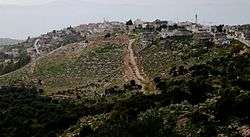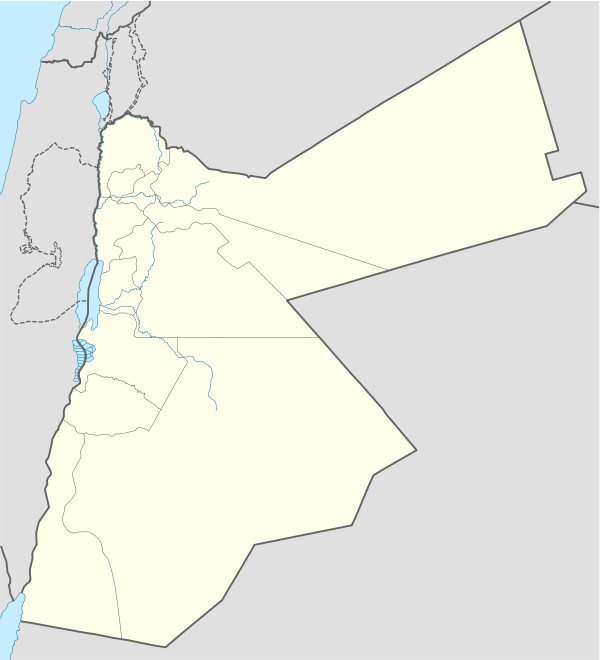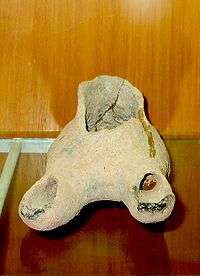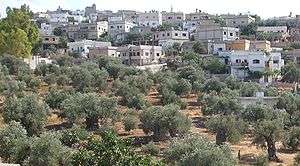Al Hashimiyya
Al Hashimiyya (/ˌælhæʃˈmiːə/; Arabic: الهاشمية al-Hāshimīyah) is a village in the Ajloun Governorate of north-western Jordan. The village is located 7 km northwest of Ajloun, 22 km south of Irbid and 108 km north of Amman. It is near Ajloun Castle and Tell Mar Elias. The largest tribes are Bani 'Ata (بني عطا), Qwaqnah (قواقنة), Gharaibeh (غرايبة), Rababah (ربابعة), Za'areer (زعارير), Abu Sini (ابو صيني) and Haddad (حداد). Hashimiyya is one of the three villages that are part of the Ash Shefa Municipality (بلدية الشفا) along with Halawah (حلاوة) and Al Wahadinah (الوهادنه).
Al Hashimiyya الهاشمية | |
|---|---|
 | |
 Al Hashimiyya Location in Jordan | |
| Coordinates: 32°21′51″N 35°39′35″E | |
| Country | Jordan |
| Governorate | Ajloun Governorate |
| Area | |
| • Total | 2.41 sq mi (6.25 km2) |
| Elevation | 1,650-2,200 ft (500-670 m) |
| Population | |
| • Total | 6,515 |
| • Density | 2,700/sq mi (1,042/km2) |
| Time zone | UTC + 2 |
Geography and climate
Hashimiyya is located in the mountainous area that surrounds Ajloun. The town is situated on a ridge that leads eastward down to the floor of the Jordan Valley. The northern and eastern sides of Hashimiyya are bordered by small pockets of forest (Ras Al Khlail and Valley of the Wolves respectively). The climate is Mediterranean-like and similar to the nearby Ajloun Forest Reserve. Hashimiyya lies within the range of the Fertile Crescent making alluvial cultivation possible. Snow and rain are common in the winter months between December and February.
History
The region around Hashimiyya has been settled since the Bronze Age, as evidenced by archeological excavations in nearby Pella and Abila. The Roman era saw increased settlement and population growth in the region as the Decapolis cities prospered. Though there is little archeological evidence of an ancient town on the site of modern Hashimiyya, the town contains an ancient olive grove known locally as Al Maisor (الميسر). Furthermore, the village's ancient name, Farah (فارة), may be derived from Viera, a Roman town located in the area.[4] Evidence from pottery found in the area indicates that there was a settlement on the site of modern Hashimiyya during Mamluk/Ayyubid period.[5]
During the Byzantine era the area around Hashimiyya was highly Christianized. Today, ruins from Byzantine churches are strewn throughout the Ajloun Governorate, most notably at Tell Mar Elias. Though Hashimiyya itself does not contain any churches the Haddad family of Christians still lives in the town.

Jordan's 1967 war had a dramatic impact on the population of Hashimiyya. Before the war the town's population was so small that the oldest mosque, The Great Hashimiyya Mosque, wasn't built until 1949 by Hajj Ahmed Abusini. Most of the village's population lived in the western end, with Al-Maisor marking the village's eastern boundary. However, in the aftermath of the war many families from the Jordan Valley chose to move further inside Jordan's border. By 2000 6 more mosques were constructed to accommodate the population swell. Al-Maisor was now within the village's limits and houses reached more than a kilometer further east. Because of this population influx the more established western part of the village became a downtown with shops, bakeries, butchers and blacksmiths. The municipal building grew to contain a health center and later a dentist's office opened nearby. When paved roads came in the 1970s buses between Hashimiyya and Ajloun soon followed, making travel easy between Hashimiyya and Amman.
The development of the town was witnessed by a member of the royal family who visited the town in the 1980s. He was so impressed by the town that he reportedly said that it could no longer be called Farah (meaning musk) and changed the name to Hashimiyya (meaning Hashemite, the name of Jordan's ruling dynasty).
Economy
Al Hashimiyya's economy relies on agriculture including: wheat, pomegranates, figs, fava beans, olives and vegetables. There are also a number of goat herders. Most people work in agriculture but also work in the Army or education to supplement their income. Many people have more than one job. People in Hashimiyya work in different places but many work in Amman, the capital city. In Hashimiyya there are four kinds of shops. The first type is supermarkets. Supermarkets have sweets, chips, oil etc. The second kind is restaurants. Restaurants have sandwiches, hummus and some snacks. The third type is electrical markets. They have computers, TV and electrical machines. The last kind is internet cafés where you can surf the net.
Education

Hashimiyya witnessed many developments in teaching that happened in synchronization with the establishing of the Hashemite Kingdom of Jordan. The development appeared in village's first basic and secondary schools. There are five schools in Hashimiyya, a primary/basic (k-6) and secondary (7-12) school for boys, a basic and secondary school for girls and a small coed basic school (k-4). Hashimiyya School for Boys was established in 1925 and many of the students who studied there are now teachers, doctors and politicians. The first girls school was created in 1960.[6] All students study general science, math, Arabic, English, religion (Islam), geography, physical education and vocational training from 1st to 12th. Starting in 9th grade students study Earth science, physics and chemistry. After 10th grade they study general culture instead of history. The final two years of school (11-12) are called Tawjihi.
Local Sites
 The trees in this valley have been removed to allow olive cultivation.
The trees in this valley have been removed to allow olive cultivation. Many trees like this can be found in Al Maiser.
Many trees like this can be found in Al Maiser. View from Ras Al Khalail.
View from Ras Al Khalail. Ras Al Khalail is shaped to look like the map of Jordan.
Ras Al Khalail is shaped to look like the map of Jordan.
References
- "Wikimapia - Let's describe the whole world!". Retrieved 5 October 2014.
- Google Earth
- "Archived copy". Archived from the original on 2011-09-27. Retrieved 2009-09-12.CS1 maint: archived copy as title (link)
- "الهاشمية". Abusini.itgo.com. Retrieved 2014-08-18.
- Ajloun Castle Museum collection
- "الهاشمية". Abusini.itgo.com. Retrieved 2014-08-18.